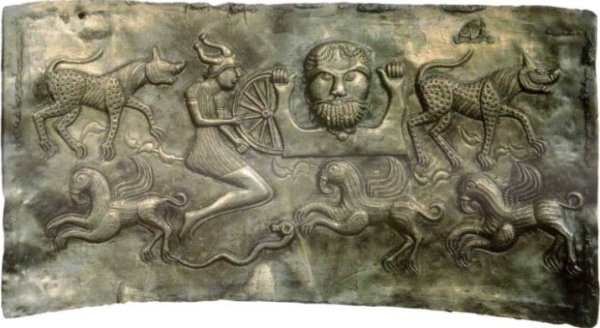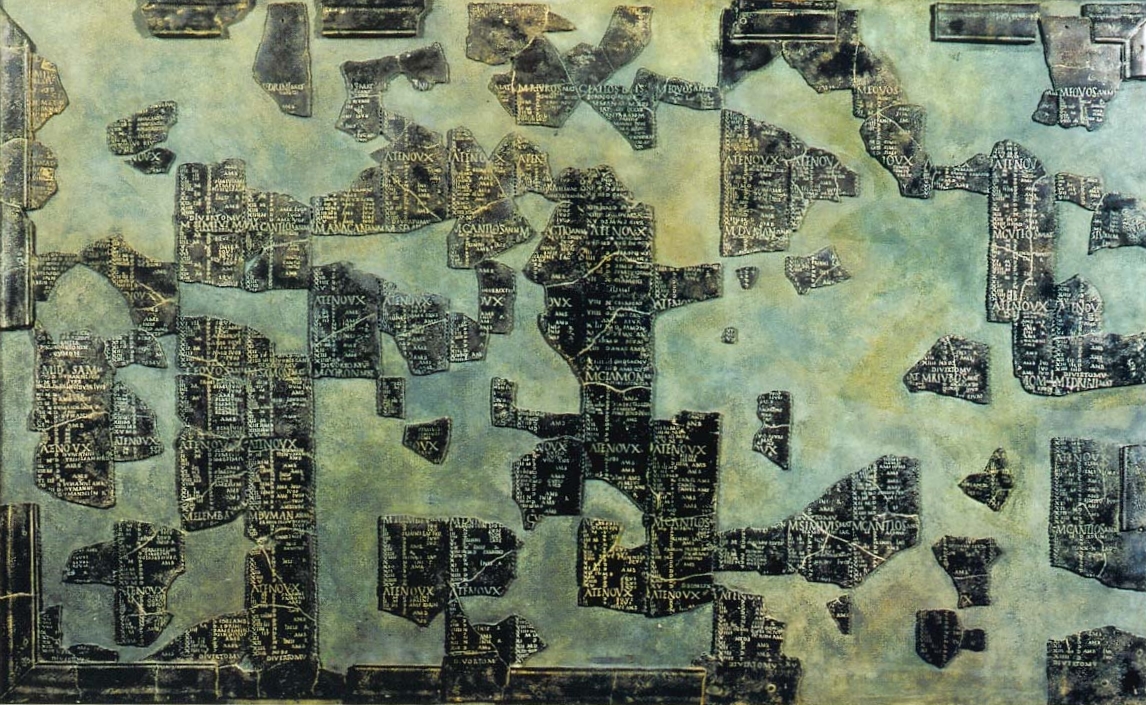|
Horned Helmet
Horned helmets were worn by many people around the world. Headpieces mounted with animal horns or replicas were also worn from ancient times, as in the Mesolithic Star Carr. These were probably used for religious ceremonial or ritual purposes, as horns tend to be impractical on a combat helmet. Much of the evidence for these helmets and headpieces comes from depictions rather than the items themselves. Prehistoric Europe Two bronze statuettes dated to the early 12th century BCE, the so-called "horned god" and "ingot god", wearing horned helmets, found in Enkomi, Cyprus. In Sardinia warriors with horned helmets are depicted in dozens of bronze figures and in the Mont'e Prama giant statues, similar to those of the Shardana warriors (and possibly belonging to the same people) depicted by the Egyptians. A pair of bronze horned helmets, the Veksø helmets, from the later Bronze Age (dating to ) were found near Veksø, Denmark, in 1942. Another early find is the ... [...More Info...] [...Related Items...] OR: [Wikipedia] [Google] [Baidu] |
Waterloo Helmet
The Waterloo Helmet (also known as the Waterloo Bridge Helmet) is a pre-Roman Celtic bronze ceremonial horned helmet with repoussé decoration in the La Tène style, dating to circa 150–50 BC, that was found in 1868 in the River Thames by Waterloo Bridge in London, England. It is now on display at the British Museum in London. Discovery The helmet was dredged from the bed of the River Thames close to Waterloo Bridge in 1868, and in March of the same year it was given on loan to the British Museum by Thames Conservancy. In 1988 its successor body, the Port of London Authority, donated the helmet to the British Museum. Description The main part of the helmet is constructed from two sheets of bronze, one forming the front and one the back of the helmet, that are riveted together at the sides and top. A separate crescent-shaped bronze piece is riveted to the bottom of the front sheet, and two conical bronze horns with terminal knobs are riveted to the top of the helmet. A deco ... [...More Info...] [...Related Items...] OR: [Wikipedia] [Google] [Baidu] |
Champron
Barding (also spelled ''bard'' or ''barb'') is body armour for Horses in warfare, war horses. The practice of armoring horses was first extensively developed in antiquity in the eastern kingdoms of Parthia and Pahlava. After the conquests of Alexander the Great it likely made its way into European military practices via the Seleucid Empire and later Byzantine Empire. Though its historical roots lie in Classical_antiquity , antiquity in the regions of what was once the Persian Empire, barded horses have become a symbol of the late European Middle Ages chivalry and the era of knights. During the Late Middle Ages as armour protection for knights became more effective, their mounts became targets. This vulnerability was exploited by the Scotland, Scots at the Battle of Bannockburn in the 14th century, when horses were killed by the infantry, and by the England, English at the Battle of Crécy in the same century where English longbow, long-bowmen shot horses and the then dismounted ... [...More Info...] [...Related Items...] OR: [Wikipedia] [Google] [Baidu] |
Torrs Pony-cap And Horns
The Torrs Horns and Torrs Pony-cap (once together known as the Torrs Chamfrein) are Iron Age bronze pieces now in the National Museum of Scotland, which were found together, but whose relationship is one of many questions about these "famous and controversial" objects that continue to be debated by scholars. Most scholars agree that horns were added to the pony-cap at a later date, but whether they were originally made for this purpose is unclear; one theory sees them as mounts for drinking-horns, either totally or initially unconnected to the cap. The three pieces are decorated in a late stage of La Tène style, as Iron Age Celtic art is called by archaeologists. The dates ascribed to the elements vary, but are typically around 200 BC; it is generally agreed that the horns are somewhat later than the cap, and in a rather different style. Whatever the original appearance and functions of the objects, and wherever they were made, they are very finely designed and skillfully execu ... [...More Info...] [...Related Items...] OR: [Wikipedia] [Google] [Baidu] |
Orange, France
Orange (; Provençal: ''Aurenja'' or ''Aurenjo'' ) is a commune in the Vaucluse department in the Provence-Alpes-Côte d'Azur region in southeastern France. It is about north of Avignon, on the departmental border with Gard, which follows the Rhône. Orange is the second-most populated city in Vaucluse, after Avignon. Name The settlement is attested as ''Arausio'' and ''Arausion'' in the first and second centuries AD, then as ''civitas Arausione'' in the fourth century, ''civitas Arausicae'' in 517 (via a Germanized form *''Arausinga''), ''Aurengia civitatis'' in 1136, and as ''Orenga'' in 1205. The name ''Arausio'' can be explained as the Gaulish ''ar-aus(i)o''- ('temple, cheek'), itself derived from an earlier Proto-Celtic *''far-aws(y)o''-, which literally means 'in front of the ear' (cf. Old Irish ''ara'', ''arae''; Ancient Greek ''pareiaí'', ''parauai'' < *''par-ausiā''). It is |
Gundestrup Cauldron
The Gundestrup cauldron is a richly decorated silver vessel, thought to date from between 200 BC and 300 AD,Nielsen, S; Andersen, J; Baker, J; Christensen, C; Glastrup, J; et al. (2005). "The Gundestrup cauldron: New scientific and technical investigations”, ''Acta Archaeologica, 76'': 1–58. Jouttijärvi, Arne (2009), "The Gundestrup Cauldron: Metallurgy and Manufacturing Techniques”, ''Materials and Manufacturing Processes, 24'': 960–966. or more narrowly between 150 BC and 1 BC. This places it within the late La Tène period or early Roman Iron Age. The cauldron is the largest known example of European Iron Age silver work (diameter: ; height: ). It was found dismantled, with the other pieces stacked inside the base, in 1891, in a peat bog near the hamlet of Gundestrup in the Aars parish of Himmerland, Denmark ().Bergquist, A K & Taylor, T F (1987), "The origin of the Gundestrup cauldron", ''Antiquity 61'': 10–24.Taylor, Timothy (1992), "The Gundestrup cauldro ... [...More Info...] [...Related Items...] OR: [Wikipedia] [Google] [Baidu] |
Gaulish
Gaulish was an ancient Celtic language spoken in parts of Continental Europe before and during the period of the Roman Empire. In the narrow sense, Gaulish was the language of the Celts of Gaul (now France, Luxembourg, Belgium, most of Switzerland, Northern Italy, as well as the parts of the Netherlands and Germany on the west bank of the Rhine). In a wider sense, it also comprises varieties of Celtic that were spoken across much of central Europe (" Noric"), parts of the Balkans, and Anatolia (" Galatian"), which are thought to have been closely related. The more divergent Lepontic of Northern Italy has also sometimes been subsumed under Gaulish. Together with Lepontic and the Celtiberian spoken in the Iberian Peninsula, Gaulish helps form the geographic group of Continental Celtic languages. The precise linguistic relationships among them, as well as between them and the modern Insular Celtic languages, are uncertain and a matter of ongoing debate because of their sparse att ... [...More Info...] [...Related Items...] OR: [Wikipedia] [Google] [Baidu] |
British Museum
The British Museum is a public museum dedicated to human history, art and culture located in the Bloomsbury area of London. Its permanent collection of eight million works is among the largest and most comprehensive in existence. It documents the story of human culture from its beginnings to the present.Among the national museums in London, sculpture and decorative and applied art are in the Victoria and Albert Museum; the British Museum houses earlier art, non-Western art, prints and drawings. The National Gallery holds the national collection of Western European art to about 1900, while art of the 20th century on is at Tate Modern. Tate Britain holds British Art from 1500 onwards. Books, manuscripts and many works on paper are in the British Library. There are significant overlaps between the coverage of the various collections. The British Museum was the first public national museum to cover all fields of knowledge. The museum was established in 1753, largely ... [...More Info...] [...Related Items...] OR: [Wikipedia] [Google] [Baidu] |
London
London is the capital and List of urban areas in the United Kingdom, largest city of England and the United Kingdom, with a population of just under 9 million. It stands on the River Thames in south-east England at the head of a estuary down to the North Sea, and has been a major settlement for two millennia. The City of London, its ancient core and financial centre, was founded by the Roman Empire, Romans as ''Londinium'' and retains its medieval boundaries.See also: Independent city#National capitals, Independent city § National capitals The City of Westminster, to the west of the City of London, has for centuries hosted the national Government of the United Kingdom, government and Parliament of the United Kingdom, parliament. Since the 19th century, the name "London" has also referred to the metropolis around this core, historically split between the Counties of England, counties of Middlesex, Essex, Surrey, Kent, and Hertfordshire, which largely comprises Greater London ... [...More Info...] [...Related Items...] OR: [Wikipedia] [Google] [Baidu] |
River Thames
The River Thames ( ), known alternatively in parts as the River Isis, is a river that flows through southern England including London. At , it is the longest river entirely in England and the second-longest in the United Kingdom, after the River Severn. The river rises at Thames Head in Gloucestershire, and flows into the North Sea near Tilbury, Essex and Gravesend, Kent, via the Thames Estuary. From the west it flows through Oxford (where it is sometimes called the Isis), Reading, Henley-on-Thames and Windsor. The Thames also drains the whole of Greater London. In August 2022, the source of the river moved five miles to beyond Somerford Keynes due to the heatwave in July 2022. The lower reaches of the river are called the Tideway, derived from its long tidal reach up to Teddington Lock. Its tidal section includes most of its London stretch and has a rise and fall of . From Oxford to the Estuary the Thames drops by 55 metres. Running through some of the drier ... [...More Info...] [...Related Items...] OR: [Wikipedia] [Google] [Baidu] |








